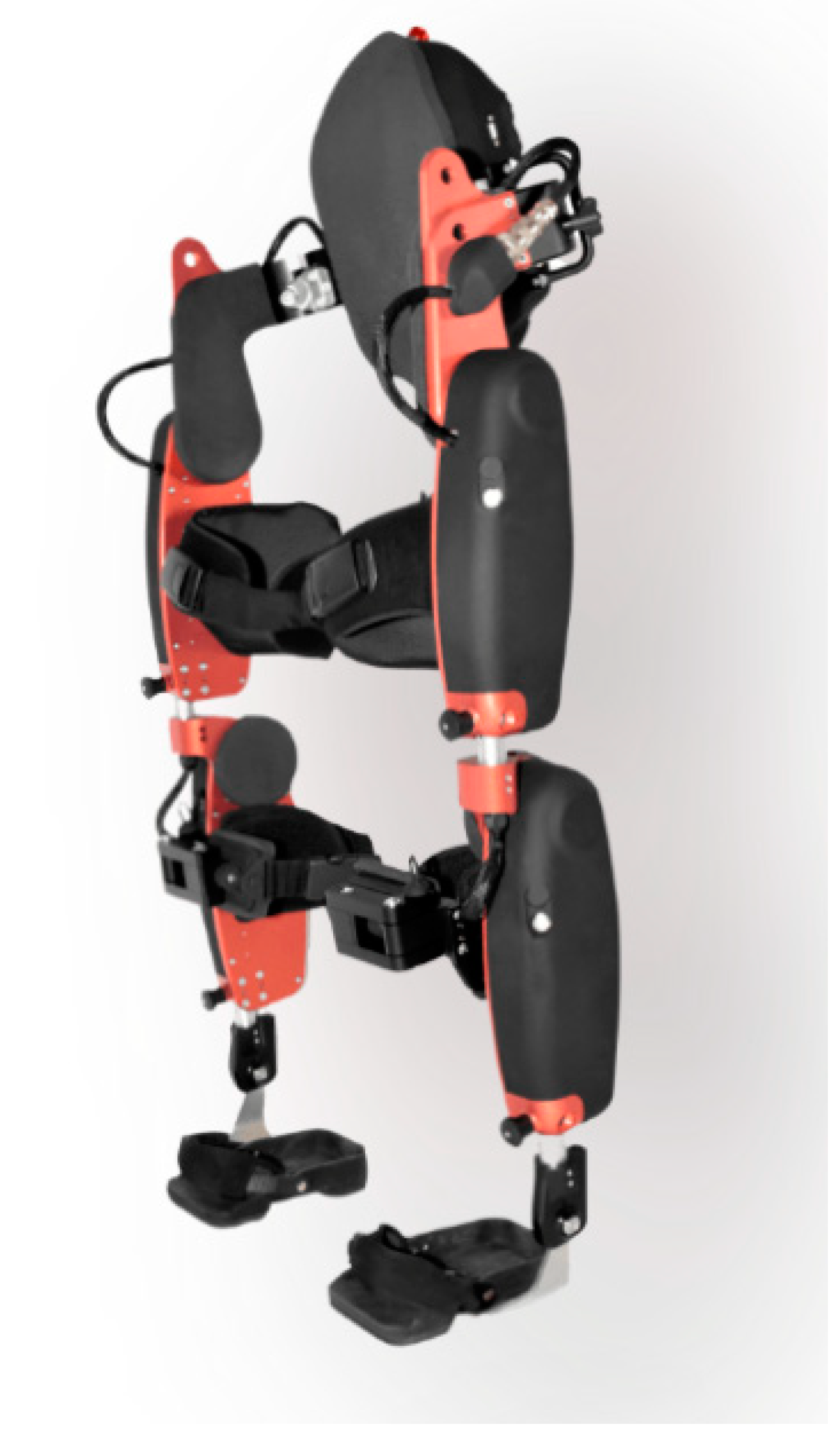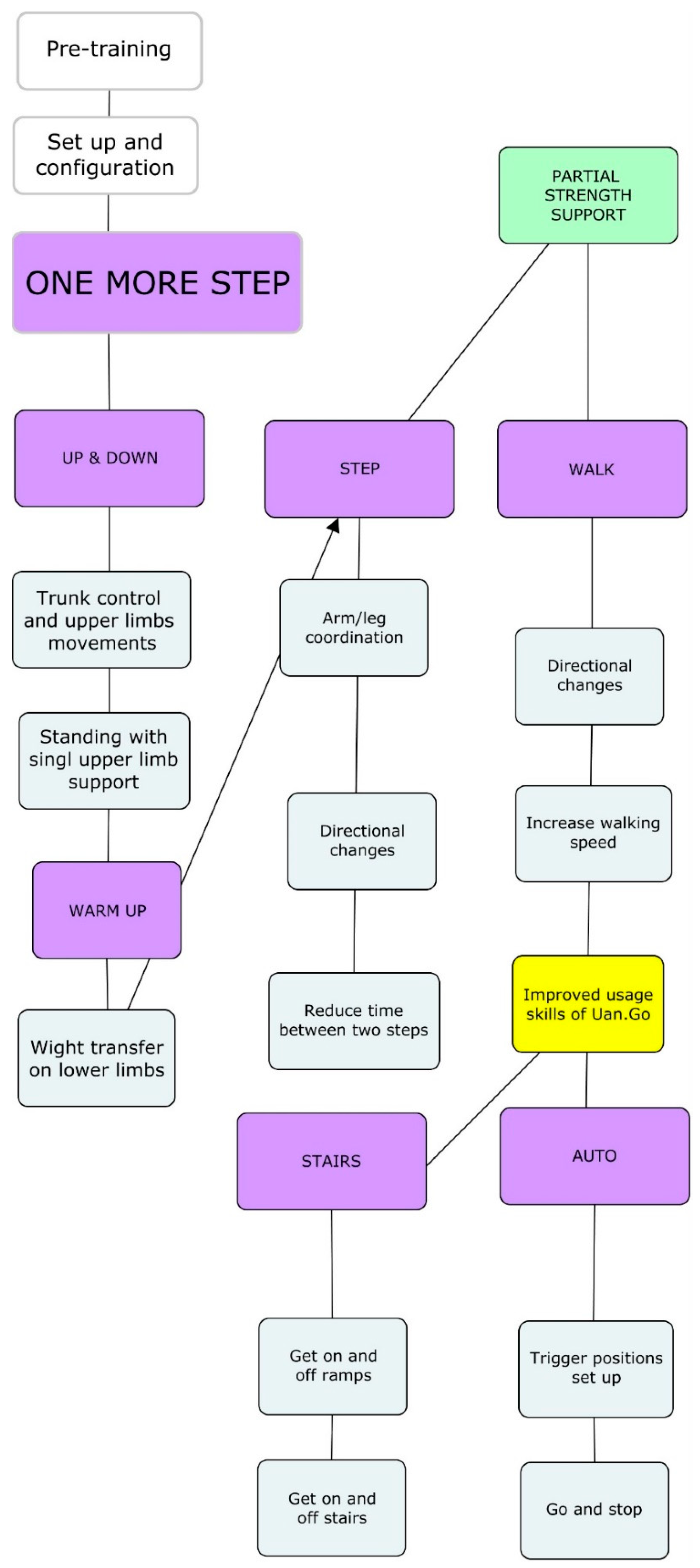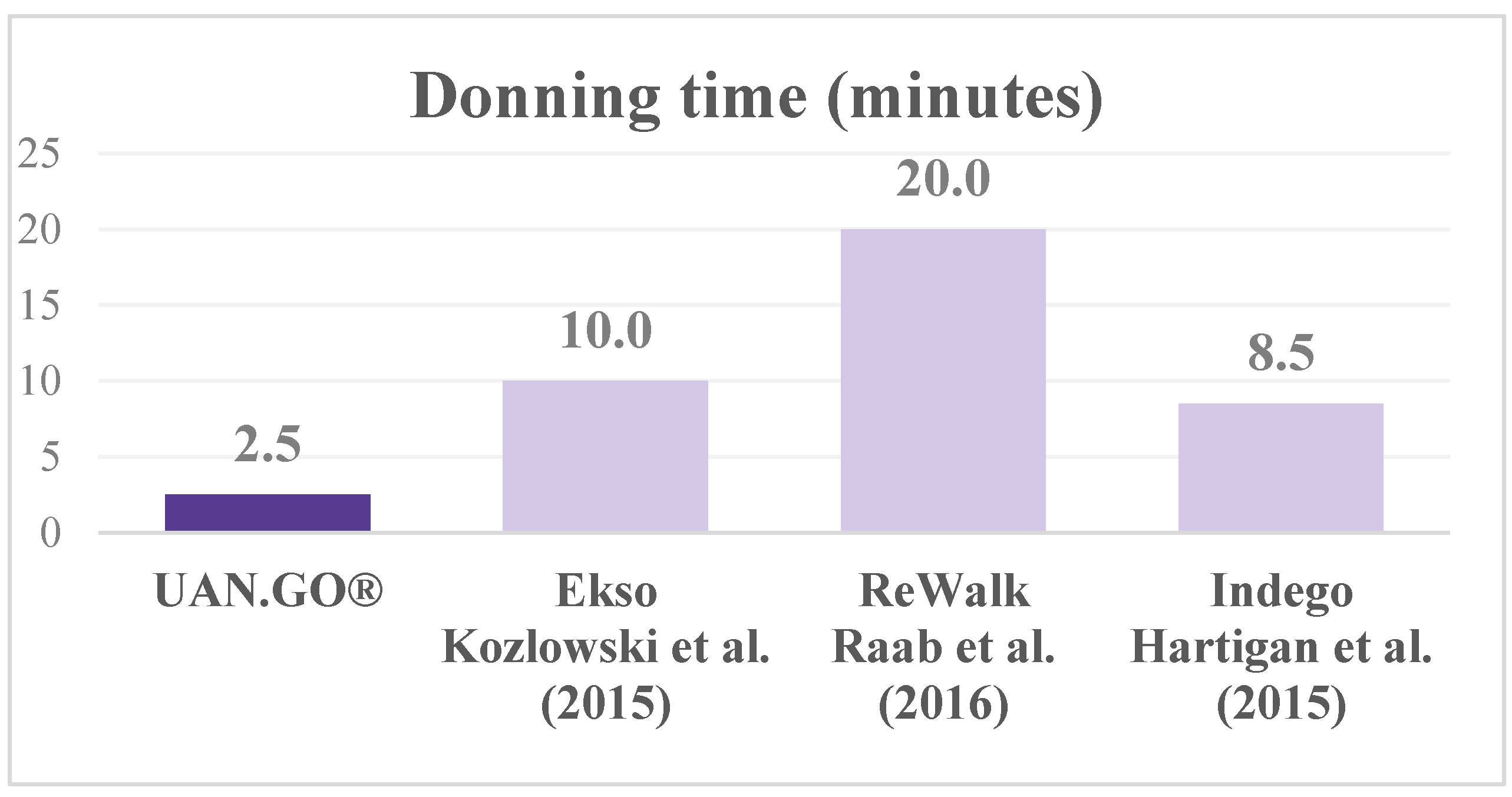Rehabilitation Program for Gait Training Using UAN.GO, a Powered Exoskeleton: A Case Report
Abstract
:1. Introduction
2. Materials and Methods
- To not force the patient to achieve skills that he is not interested in
- To respect patient’s own learning time
- To aim at an improvement of the patient’s quality of life, not only in physical terms but also psychologically and socially.
3. Results
4. Discussion
5. Conclusions
Author Contributions
Funding
Institutional Review Board Statement
Informed Consent Statement
Data Availability Statement
Conflicts of Interest
References
- Alizadeh, A.; Dyck, S.M.; Karimi-Abdolrezaee, S. Traumatic spinal cord injury: An overview of pathophysiology, models and acute injury mechanisms. Front. Neurol. 2019, 10, 282. [Google Scholar] [CrossRef] [PubMed] [Green Version]
- Bennett, J.; Das, J.M.; Emmady, P.D. Spinal Cord Injuries. In StatPearls; StatPearls Publishing: Treasure Island, FL, USA, 2021. Available online: http://www.ncbi.nlm.nih.gov/books/NBK560721/ (accessed on 13 October 2021).
- Wilson, J.R.; Cadotte, D.W.; Fehlings, M.G. Clinical predictors of neurological outcome, functional status, and survival after traumatic spinal cord injury: A systematic review. J. Neurosurg. Spine 2012, 17 (Suppl. 1), 11–26. [Google Scholar] [CrossRef] [PubMed]
- Hubscher, C.H.; Herrity, A.N.; Williams, C.S.; Montgomery, L.R.; Willhite, A.M.; Angeli, C.A.; Harkema, S.J. Improvements in bladder, bowel and sexual outcomes following task-specific locomotor training in human spinal cord injury. PLoS ONE 2018, 13, e0190998. [Google Scholar] [CrossRef] [PubMed] [Green Version]
- Nash, M.S.; Groah, S.L.; Gater, D.R., Jr.; Dyson-Hudson, T.A.; Lieberman, J.A.; Myers, J.; Sabharwal, S.; Taylor, A.J. Identification and Management of Cardiometabolic Risk after Spinal Cord Injury: Clinical Practice Guideline for Health Care Providers. Top. Spinal Cord Inj. Rehabil. 2018, 24, 379–423. [Google Scholar] [CrossRef] [PubMed]
- Sezer, N.; Akkuş, S.; Uğurlu, F.G. Chronic complications of spinal cord injury. World J. Orthop. 2015, 6, 24–33. [Google Scholar] [CrossRef]
- Post, M.W.M.; Van Leeuwen, C.M.C. Psychosocial issues in spinal cord injury: A review. Spinal Cord 2012, 50, 382–389. [Google Scholar] [CrossRef]
- Burns, A.S.; Marino, R.J.; Flanders, A.E.; Flett, H. Clinical diagnosis and prognosis following spinal cord injury. Handb. Clin. Neurol. 2012, 109, 47–62. [Google Scholar]
- Côté, M.-P.; Murray, M.; Lemay, M.A. Rehabilitation Strategies after Spinal Cord Injury: Inquiry into the Mechanisms of Success and Failure. J. Neurotrauma 2017, 34, 1841–1857. [Google Scholar] [CrossRef] [Green Version]
- Burns, A.S.; Marino, R.J.; Kalsi-Ryan, S.; Middleton, J.W.; Tetreault, L.A.; Dettori, J.R.; Mihalovich, K.E.; Fehlings, M.G. Type and Timing of Rehabilitation Following Acute and Subacute Spinal Cord Injury: A Systematic Review. Glob. Spine J. 2017, 7 (Suppl. 3), 175S–194S. [Google Scholar] [CrossRef] [PubMed] [Green Version]
- Chen, G.; Chan, C.K.; Guo, Z.; Yu, H. A Review of Lower Extremity Assistive Robotic Exoskeletons in Rehabilitation Therapy. Crit. Rev. Biomed. Eng. 2013, 41, 343–363. [Google Scholar] [CrossRef]
- Tan, K.; Koyama, S.; Sakurai, H.; Teranishi, T.; Kanada, Y.; Tanabe, S. Wearable robotic exoskeleton for gait reconstruction in patients with spinal cord injury: A literature review. J. Orthop. Transl. 2021, 28, 55–64. [Google Scholar] [CrossRef]
- Chisholm, A.E.; AlAmro, R.A.; Williams, A.M.M.; Lam, T. Overground vs. treadmill-based robotic gait training to improve seated balance in people with motor-complete spinal cord injury: A case report. J. Neuroeng. Rehabil. 2017, 14, 27. [Google Scholar] [CrossRef] [PubMed]
- Sale, P.; Russo, E.F.; Russo, M.; Masiero, S.; Piccione, F.; Calabrò, R.S.; Filoni, S. Effects on mobility training and de-adaptations in subjects with Spinal Cord Injury due to a Wearable Robot: A preliminary report. BMC Neurol. 2016, 16, 12. [Google Scholar] [CrossRef] [Green Version]
- Donati, A.R.; Shokur, S.; Morya, E.; Campos, D.S.; Moioli, R.C.; Gitti, C.M.; Augusto, P.B.; Tripodi, S.; Pires, C.G.; Pereira, G.A.; et al. Long-Term Training with a Brain-Machine Interface-Based Gait Protocol Induces Partial Neurological Recovery in Paraplegic Patients. Sci. Rep. 2016, 6, 30383. [Google Scholar] [CrossRef] [PubMed] [Green Version]
- Martin Ginis, K.A.; Latimer, A.E. The effects of single bouts of body-weight supported treadmill training on the feeling states of people with spinal cord injury. Spinal Cord 2007, 45, 112–115. [Google Scholar] [CrossRef] [PubMed] [Green Version]
- Chun, A.; Asselin, P.K.; Knezevic, S.; Kornfeld, S.; Bauman, W.A.; Korsten, M.A.; Harel, N.Y.; Huang, V.; Spungen, A.M. Changes in Bowel Function Following Exoskeletal-Assisted Walking in Persons with Spinal Cord Injury: An Observational Pilot Study. Spinal Cord 2020, 58, 459–466. [Google Scholar] [CrossRef]
- Yildirim, M.A.; Öneş, K.; Gökşenoğlu, G. Early term effects of robotic assisted gait training on ambulation and functional capacity in patients with spinal cord injury. Turk. J. Med. Sci. 2019, 49, 838–843. [Google Scholar] [CrossRef]
- Van Dijsseldonk, R.B.; Van Nes, I.J.W.; Geurts, A.C.H.; Keijsers, N.L.W. Exoskeleton home and community use in people with complete spinal cord injury. Sci. Rep. 2020, 10, 15600. [Google Scholar] [CrossRef] [PubMed]
- Postol, N.; Spratt, N.J.; Bivard, A.; Marquez, J. Physiotherapy using a free-standing robotic exoskeleton for patients with spinal cord injury: A feasibility study. J. Neuroeng. Rehabil. 2021, 18, 180. [Google Scholar] [CrossRef]
- Charbonneau, R.; Loyola-Sanchez, A.; McIntosh, K.; MacKean, G.; Ho, C. Exoskeleton use in acute rehabilitation post spinal cord injury: A qualitative study exploring patients’ experiences. J. Spinal Cord Med. 2021, 2, 1–9. [Google Scholar] [CrossRef]
- Xiang, X.-N.; Zong, H.-Y.; Ou, Y.; Yu, X.; Cheng, H.; Du, C.-P.; He, H.-C. Exoskeleton-assisted walking improves pulmonary function and walking parameters among individuals with spinal cord injury: A randomized controlled pilot study. J. Neuroeng. Rehabil. 2021, 18, 86. [Google Scholar] [CrossRef] [PubMed]
- Okawara, H.; Sawada, T.; Matsubayashi, K.; Sugai, K.; Tsuji, O.; Nagoshi, N.; Matsumoto, M.; Nakamura, M. Gait ability required to achieve therapeutic effect in gait and balance function with the voluntary driven exoskeleton in patients with chronic spinal cord injury: A clinical study. Spinal Cord 2019, 58, 520–527. [Google Scholar] [CrossRef] [PubMed]
- Wu, C.-H.; Mao, H.-F.; Hu, J.-S.; Wang, T.-Y.; Tsai, Y.-J.; Hsu, W.-L. The effects of gait training using powered lower limb exoskeleton robot on individuals with complete spinal cord injury. J. Neuroeng. Rehabil. 2018, 15, 14. [Google Scholar] [CrossRef] [Green Version]
- Chang, S.-H.; TIRR SCI Clinical Exoskeleton Group; Afzal, T.; Berliner, J.; Francisco, G.E. Exoskeleton-assisted gait training to improve gait in individuals with spinal cord injury: A pilot randomized study. Pilot Feasibility Stud. 2018, 4, 62. [Google Scholar] [CrossRef] [PubMed] [Green Version]
- Khan, A.S.; Livingstone, D.C.; Hurd, C.L.; Duchcherer, J.; Misiaszek, J.E.; Gorassini, M.A.; Manns, P.J.; Yang, J.F. Retraining walking over ground in a powered exoskeleton after spinal cord injury: A prospective cohort study to examine functional gains and neuroplasticity. J. Neuroeng. Rehabil. 2019, 16, 145. [Google Scholar] [CrossRef] [Green Version]
- Asselin, P.K.; Avedissian, M.; Knezevic, S.; Kornfeld, S.; Spungen, A.M. Training Persons with Spinal Cord Injury to Ambulate Using a Powered Exoskeleton. J. Vis. Exp. JoVE 2016, 16, 54071. [Google Scholar] [CrossRef] [Green Version]
- Fang, C.-Y.; Tsai, J.-L.; Li, G.-S.; Lien, A.S.-Y.; Chang, Y.-J. Effects of Robot-Assisted Gait Training in Individuals with Spinal Cord Injury: A Meta-analysis. BioMed Res. Int. 2020, 2020, 2102785. [Google Scholar] [CrossRef]
- Louie, D.R.; Spinal Cord Injury Research Evidence (SCIRE) Research Team; Eng, J.J.; Lam, T. Gait speed using powered robotic exoskeletons after spinal cord injury: A systematic review and correlational study. J. Neuroeng. Rehabil. 2015, 12, 82. [Google Scholar] [CrossRef] [Green Version]
- Kirshblum, S.C.; Burns, S.P.; Biering-Sorensen, F.; Donovan, W.; Graves, D.E.; Jha, A.; Johansen, M.; Jones, L.; Krassioukov, A.; Mulcahey, M.J.; et al. International standards for neurological classification of spinal cord injury (Revised 2011). J. Spinal Cord Med. 2011, 34, 535–546. [Google Scholar] [CrossRef] [Green Version]
- AVEN. Guideline for the Identification of Experimental Thesis to Be Submitted to the Ethics Committee Approval. Available online: https://www.aou.mo.it/ComitatoEticoAVEN (accessed on 8 June 2021).
- Scivoletto, G.; Tamburella, F.; Laurenza, L.; Foti, C.; Ditunno, J.F.; Molinari, M. Validity and reliability of the 10-m walk test and the 6-min walk test in spinal cord injury patients. Spinal Cord 2011, 49, 736–740. [Google Scholar] [CrossRef]
- Borg, G.A. Psychophysical bases of perceived exertion. Med. Sci. Sports Exerc. 1982, 14, 377–381. [Google Scholar] [CrossRef] [PubMed]
- Bohannon, R.W.; Crouch, R. Minimal clinically important difference for change in 6-minute walk test distance of adults with pathology: A systematic review. J. Eval. Clin. Pract. 2016, 23, 377–381. [Google Scholar] [CrossRef] [PubMed]
- Riley, D.S.; Barber, M.S.; Kienle, G.S.; Aronson, J.K.; von Schoen-Angerer, T.; Tugwell, P.; Kiene, H.; Helfand, M.; Altman, D.G.; Sox, H.; et al. CARE guidelines for case reports: Explanation and elaboration document. J. Clin. Epidemiol. 2017, 89, 218–235. [Google Scholar] [CrossRef] [PubMed]
- Kozlowky, A.J.; Bryce, T.N.; Dijkers, M.P. Time and Effort Required by Persons with Spinal Cord Injury to Learn to Use a Powered Exoskeleton for Assisted Walking. Top. Spinal Cord Inj. Rehabil. 2015, 21, 110–121. [Google Scholar]
- Raab, K.; Krakow, K.; Tripp, F.; Jung, M. Effects of training with the ReWalk exoskeleton on quality of life in incomplete spinal cord injury: A single case study. Spinal Cord Ser. Cases 2016, 2, 15025. [Google Scholar] [CrossRef] [Green Version]
- Hartigan, C.; Kandilakis, C.; Dalley, S.; Clausen, M.; Wilson, E.; Morrison, S.; Etheridge, S.; Farris, R. Mobility Outcomes Following Five Training Sessions with a Powered Exoskeleton. Top. Spinal Cord Inj. Rehabil. 2015, 21, 93–99. [Google Scholar] [CrossRef] [Green Version]
- Delgado, A.D.; Escalon, M.; Bryce, T.N.; Weinrauch, W.; Suarez, S.J.; Kozlowski, A.J. Safety and feasibility of exoskeleton-assisted walking during acute/sub-acute SCI in an inpatient rehabilitation facility: A single-group preliminary study. J. Spinal Cord Med. 2019, 43, 657–666. [Google Scholar] [CrossRef]
- Spungen, A.M.; Asselin, P.K.; Fineberg, D.B.; Kornfeld, S.D.; Harel, N.Y. Exoskeletal-Assisted Walking for Persons with motor complete paraplegia; James J Peters VA Medical Center: New York, NY, USA, 2013; pp. 1–14. [Google Scholar]
- Spencer, L.; Zafiropoulos, B.; Denniss, W.; Fowler, D.; Alison, J.; Celermajer, D. Is there a learning effect when the 6-minute walk test is repeated in people with suspected pulmonary hypertension? Chron. Respir. Dis. 2018, 15, 339–346. [Google Scholar] [CrossRef]
- Hollman, J.H.; McDade, E.M.; Petersen, R.C. Normative spatiotemporal gait parameters in older adults. Gait Posture 2011, 34, 111–118. [Google Scholar] [CrossRef] [Green Version]
- van Dijsseldonk, R.B.; Rijken, H.; van Nes, I.J.W.; van de Meent, H.; Keijsers, N.L.W. A Framework for Measuring the Progress in Exoskeleton Skills in People with Complete Spinal Cord Injury. Front. Neurosci. 2017, 11, 699. [Google Scholar] [CrossRef] [Green Version]
- van Dijsseldonk, R.B.; Rijken, H.; van Nes, I.J.W.; van de Meent, H.; Keijsers, N.L.W. Predictors of exoskeleton motor learning in spinal cord injured patients. Disabil. Rehabil. 2021, 43, 1982–1988. [Google Scholar] [CrossRef] [PubMed] [Green Version]
- Miller, L.; Zimmermann, A.; Herbert, W. Clinical effectiveness and safety of powered exoskeleton-assisted walking in patients with spinal cord injury: Systematic review with meta-analysis. Med. Devices 2016, 9, 455–466. [Google Scholar] [CrossRef] [PubMed] [Green Version]






| Inclusion Criteria | Exclusion Criteria |
|---|---|
| Lower limbs weakness or paralysis | Heterotopic ossifications limiting ROM |
| The ability to understand and sign the | Unhealed fractures or instable vertebral |
| informed consent and the liability waiver | column |
| Absence of functional ROM limitations | Persistent orthostatic hypotension |
| Ashworth Scale lower or equal to 3 | Uncontrolled autonomic dysreflexia |
| Upper limbs preservation and ability to use a walker or crutches | Skin integrity issues |
| Ability to follow directions | Hospitalization during the last 3 months due to heart attack, heart surgery acute earth failure |
| Preserved learning ability | Cognitive or psychiatric disorders that can interfere with the conduct of the training |
| Height between 160 cm and 195 cm | Significant osteoporosis |
| Weight lower than 100 kg | Pregnancy |
| Skill | Session | |||
|---|---|---|---|---|
| Dressing | Donning | 1 | ||
| Doffing | 1 | |||
| Fastening tibial bands | 2 | |||
| Fastening femoral bands | 2 | |||
| Fastening abdomnial band | 1 | |||
| Sets feet on the plantar support | 2 | |||
| Pre-walk | Up | 1 | ||
| Up autonomous | 4 | |||
| Down | 1 | |||
| Down autonomous | 4 | |||
| Warm up | 1 | |||
| Step | 1 | |||
| 4 steps autonomous | 5 | |||
| Directional changes | 4 | |||
| Walk | Easy-map 0.26 m | Slow | 1 | |
| Medium | 1 | |||
| Fast | 1 | |||
| Intermediate map 0.48 m | Slow | 2 | ||
| Medium | 3 | |||
| Fast | 4 | |||
| Advanced 0.64 m | Slow | 13 | ||
| Medium | 13 | |||
| Fast | - | |||
| 6MWT | Walked distance | Borg | Breaks | |
| 45.64 m | 15 | 4 | 4 | |
| 60.42 m | 15 | - | 5 | |
| 58.5 m | 16 | 1 | 6 | |
| 64.27 m | 15 | - | 7 | |
| 71.83 m | 18 | 1 | 8 | |
| 75.84 m | 15 | 1 | 9 | |
| 77.28 m | 15 | 2 | 10 | |
| 76.8 m | 13 | - | 11 | |
| 74.42 m | 15 | 1 | 12 | |
| 84.87 m | 15 | - | 13 | |
Publisher’s Note: MDPI stays neutral with regard to jurisdictional claims in published maps and institutional affiliations. |
© 2022 by the authors. Licensee MDPI, Basel, Switzerland. This article is an open access article distributed under the terms and conditions of the Creative Commons Attribution (CC BY) license (https://creativecommons.org/licenses/by/4.0/).
Share and Cite
Lamberti, G.; Sesenna, G.; Paja, Q.; Ciardi, G. Rehabilitation Program for Gait Training Using UAN.GO, a Powered Exoskeleton: A Case Report. Neurol. Int. 2022, 14, 536-546. https://doi.org/10.3390/neurolint14020043
Lamberti G, Sesenna G, Paja Q, Ciardi G. Rehabilitation Program for Gait Training Using UAN.GO, a Powered Exoskeleton: A Case Report. Neurology International. 2022; 14(2):536-546. https://doi.org/10.3390/neurolint14020043
Chicago/Turabian StyleLamberti, Gianfranco, Gianluca Sesenna, Qamil Paja, and Gianluca Ciardi. 2022. "Rehabilitation Program for Gait Training Using UAN.GO, a Powered Exoskeleton: A Case Report" Neurology International 14, no. 2: 536-546. https://doi.org/10.3390/neurolint14020043
APA StyleLamberti, G., Sesenna, G., Paja, Q., & Ciardi, G. (2022). Rehabilitation Program for Gait Training Using UAN.GO, a Powered Exoskeleton: A Case Report. Neurology International, 14(2), 536-546. https://doi.org/10.3390/neurolint14020043






